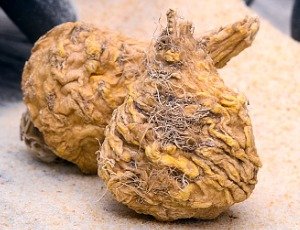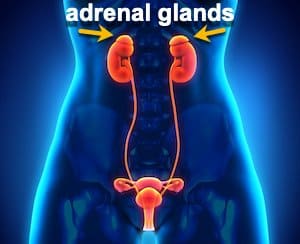More than two centuries ago, Peruvians discovered that a tuberous vegetable growing high in the Andes mountain range had some noticeable benefits for their health and endurance. Men going into battle or performing other physical feats would take maca because they observed that it gave them stamina, strength, and virility.
Meanwhile, women who consumed maca had better reproductive health, energy, and focus. Does maca have something special in it that confers all of these benefits? Read on to discover just what it is that makes maca so marvelous.
What Is Maca?
Growing at an elevation of 12-14,000 feet above sea level in the Andes mountains of Peru, maca grows in extreme weather  conditions. Thriving in a habitat of intense sunlight, cold temperatures, and strong winds, this tuberous plant is a part of the brassica family. Just like cauliflower, broccoli, and cabbage, maca is a cruciferous vegetable.
conditions. Thriving in a habitat of intense sunlight, cold temperatures, and strong winds, this tuberous plant is a part of the brassica family. Just like cauliflower, broccoli, and cabbage, maca is a cruciferous vegetable.
Nutrients Found in Maca
Maca contains plenty of healthy fatty acids, the most abundant being linoleic, oleic, and palmitic acids. Maca contains vitamins A, C, B2, B6, and niacin, as well as minerals – zinc, iron, iodine, copper, calcium, potassium, and magnesium. Nine amino acids are considered essential for optimal health, and maca contains seven of them [1].
Maca is also a rich source of plant sterols, which are part of what makes it so beneficial for hormonal health. Plant sterols are (chemically speaking) structurally similar to the body’s own hormones such as estrogen, progesterone, and testosterone.
Maca Is an Adaptogen
So how exactly does it work? Maca is an adaptogen, meaning that it works to strengthen, balance, and help the body respond to internal and external changes and stressors. It regulates the production of hormones to maintain healthy organ function. Maca feeds the hypothalamus, pituitary, and adrenal glands, known as the Master Glands (more on that later).
Maca’s plant sterols appear to stimulate changes in the action of the hypothalamus, pituitary, and adrenal glands. Maca also seems to exert an influence on the ovaries, pineal gland, and thyroid.
How Maca Can Aid Fluctuating Hormones
Premenstrual Syndrome (PMS) is one of the most common complaints among women of reproductive age. When out of balance, estrogen – the hormone responsible for regulating the reproductive system – can cause a wide range of symptoms and annoyances for women (and their men!).
Mood swings, water retention, fatigue, food cravings, irritability, headaches, irregular menstrual periods, painful cramping… all can be attributable to estrogen imbalance.
Maca can help ease the rapid rise and fall of hormones in menstruating women due to its adaptogenic properties. Also, by improving the connection between the brain and the pituitary gland, maca’s ability to help balance levels of circulating hormones is further enhanced. Most PMS sufferers taking maca report a marked improvement in symptoms during their first menstrual period after commencement of maca.
Other times when maca may be of benefit to women is after coming off birth control pills, and after having a baby and breastfeeding has ceased. At such times, endocrine system function can be depleted, and maca’s adaptogenic properties mean it can help the body right itself again.

Maca can also ease many of the symptoms of perimenopause and menopause. For those harried by hot flashes, night sweats, insomnia, depression, anxiety, and lack of energy, maca can provide some much-needed relief. Maca does not appear to mimic estrogen in the body but it can help to increase the body’s production of estrogen if levels are too low. That’s the beauty of an adaptogenic herb: it adapts to what the body needs.
In a 2006 clinical trial, 34 early-postmenopausal women were given a supplement containing either maca or a placebo twice per day for four months. Those receiving the maca had increased levels of estrogen, suppressed levels of FSH, T3 thyroid hormone, adrenocorticotropic hormone, and cortisol (the hormone secreted in response to stress). Body mass index also decreased. Iron levels increased, however, as did bone density markers, and maca relieved many of the symptoms of menopausal discomfort such as hot flashes and night sweats [2].
Another small 2014 clinical study found that maca reduced blood pressure and depression in postmenopausal women [3].
Can Maca Can Also Benefit Men?
Maca can also be helpful for male health. Recent studies have indicated that maca may assist male health by helping to increase sperm count and motility, increasing sexual desire, protecting the prostate and reducing the incidence of benign prostatic hyperplasia, reducing stress and depression, boosting energy levels, and easing mild erectile dysfunction [1, 4].
8 Additional Health Benefits of Maca
#1. Boosts Energy and Endurance
A 2009 study of male cyclists found that maca supplementation did indeed improve cycling time performance, as well as sexual desire (a perk for many) [5].
#2. Hypothalamus/Pituitary/Adrenal (HPA) Gland Nourishment
HPA glands are called the “Master Glands” because they regulate other glands (you may also hear it termed the “HPA Axis”). When HPA is well nourished, other glands of the body benefit as well. When under stress, the adrenal gland takes a big hit, especially if the stress moves from acute (short-lasting stress) to chronic (long-lasting stress).
Maca feeds all three glands by supporting the body’s production of hormones, either increasing or decreasing levels according to the need. As a result, maca may help prevent or repair adrenal exhaustion and all of the unhealthy follow-on effects this has on the body and mind.
#3. Libido Booster
Maca has been used traditionally by Peruvians to boost virility and libido. Science has not yet determined how maca does this, but it has been called “Nature’s Viagra” for good reason.
Some health experts believe maca’s effects on libido may be caused by its long-chain fatty acids known as macaenes and macamides, which are unique and have not been found in any other plant.
A 2008 clinical study followed women suffering from sexual dysfunction caused by selective serotonin reuptake inhibitors (SSRIs) for depression. The study found that three grams of maca per day gave significant improvement in libido for the women taking it [6].
#4. Cardiovascular Health
Maca’s phytosterols – campesteroland beta-sitosterol, act to interfere with the absorption of LDL cholesterol (the so-called “bad” cholesterol), making maca beneficial for the cardiovascular system [7]. Phytosterols have also been studied for their anti-inflammatory effects, which assist in balancing the immune system, and, as an added bonus, help to protect the body from abnormal cell growth.
cholesterol (the so-called “bad” cholesterol), making maca beneficial for the cardiovascular system [7]. Phytosterols have also been studied for their anti-inflammatory effects, which assist in balancing the immune system, and, as an added bonus, help to protect the body from abnormal cell growth.
#5. Anti-Cancer
A 2015 study found that phytosterols interfere with many different pathways in the carcinogenesis (cancer beginning) process [8]. In addition, an animal study found that beta-sitosterol decreased levels of circulating estrogen, and inhibited the growth of estrogen-receptor positive breast cancer tumors [9].
#6. Boosts Immunity
The phytosterols in maca stimulate the immune system and increased levels of interleukin-2 and natural killer cells [7] which the body needs to fight abnormal cell growth.
#7. Liver Support
Being a cruciferous vegetable, maca contains glucosinolates which, when chewed and digested, change into health-promoting chemicals that help protect against cancer. Sulfur-containing glucosinolates form bonds that help the body’s enzymes do their work better.
Both sulfur and plant sterols are required in the production of a master antioxidant called glutathione which boosts liver function and helps the liver with detoxification [10].
#8. Healthy Bones
Maca’s vitamins and minerals can help to build strong, healthy bones. A 2006 clinical trial found that maca increased bone density markers for the early-postmenopausal women taking it [2].
How to Take Maca
Look for organic maca powder grown in Peru. Maca can be added to juices, oatmeal, inside sandwiches, sprinkled on salads, and added to raw food recipes. Just keep in mind that it is best not to heat maca powder to high temperatures which might diminish some of its nutrients. If you use it in recipes, add it after cooking, just before serving.
A gentle approach is generally the best way to begin taking maca.
Recommendations are to start with a small dose of 1 teaspoon per day. If that is well tolerated, gradually increase the dose to 1 tablespoon, or more. If you haven’t noticed any improvement, remember one trial had women taking 3 grams per day.
It can take two or three weeks before you may notice the full benefits of maca. It is also recommended to only take maca daily for a few months and then take a break from it for a month or so before resuming consumption again.
Some health experts recommend avoiding maca under the following conditions. Please consult with your own healthcare provider if:
- you are between the ages of 15 and 35, have a good, mainly plant-based diet, and don’t have mood swings, fluid retention, or any of the symptoms of PMS
- you have an allergy to iodine
- you have Hashimoto’s disease or hyperthyroid condition
If hormonal fluctuations are creating havoc in your life, consult your natural health practitioner to see if maca might be right for you.
Organixx Clean Sourced Collagens blend contains five types of collagen from four sources. What’s more, it’s combined with targeted nutrients such as zinc, vitamin C, and vitamin B6 which specifically enhance the bioavailability and potency of collagen. Clean Sourced Collagens is formulated from the ground up to enhance and support your body’s natural ability to heal and rebuild itself from the INSIDE out.

Menopause (the ceasing of menstruation and reproduction) is a normal change that a woman will go through on average between the ages of 50 and 55 – although it can happen much earlier. Understanding the changes that happen in the body is vital, as natural decline in hormone levels during menopause can significantly affect a woman’s health for years to come.
The menopause process is gradual and has a few stages along the way. It starts as perimenopause, during which time the ovaries begin to make less of the hormones estrogen and progesterone, which interferes with an egg being consistently released each month. (By the way, the term menopause actually refers to when a woman has been 12 consecutive months without a period or other signs of fertility. Postmenopause is the stage after menopause has occurred. However many people use the term “menopause” to describe the entire process.)
The decline of hormone production starts slow (typically around age 35) and speeds up through her 40s as a woman approaches actual menopause. At some point during this transition, the ovaries get smaller and stop producing estrogen and progesterone altogether. At this stage, the adrenals take over the job of producing the sex hormones and menopause symptoms often become more pronounced.
The Problem With Diminishing Progesterone
The adrenal glands are widely known for the production of the stress hormones cortisol and adrenaline. But what many people  don’t realize is that the adrenals also produce other hormones, including the sex hormones estrogen and progesterone.
don’t realize is that the adrenals also produce other hormones, including the sex hormones estrogen and progesterone.
The adrenal glands are part of your long-term, back-up hormonal replacement part system and are designed to release whatever female hormone you may need. However, if the adrenals are not functioning well, sufficient progesterone won’t be produced which can cause havoc in the body.
The main purpose of progesterone is to prepare the body for pregnancy and provide the necessary support to ensure the fetus is carried to term. However, that is not the only role that progesterone plays in a woman’s body.
Progesterone is responsible for many important tasks, such as:
- increasing libido
- protecting against fibrocystic breast disease
- maintaining the uterine lining
- hydrating and oxygenating the skin
- decreasing hair thinning
- acting as a natural diuretic
- helping protect against depression and increasing a sense of well-being
- encouraging fat burning and the use of stored energy
- improving clarity
- promoting good sleep
Other Hormones Also Need Progesterone
Progesterone is also the precursors for other important stress and sex hormones (which means it’s needed to make other hormones). While estrogen levels don’t fall until later in the menopause transition, progesterone levels decline sooner and more dramatically leading up to menopause.
Body signals that include symptoms such as hot flashes are most likely the result in a shift in the balance between estrogen and progesterone.

The Impact of Stress on Progesterone
Another risk to progesterone is that the body releases cortisol in response to physical and psychological stress.
When we experience periods of stress, our bodies excrete cortisol to help us work through whatever the situation may be. If there’s a high demand for cortisol due to prolonged stress and the body is unable to keep up with the supply, it will take from cortisol’s pre-hormone, pregnenolone (the mother hormone of all sex hormones).
When more of pregnenolone is used to make cortisol, less will be available to make progesterone, which will further exacerbate menopausal symptoms and affect overall well-being.
The short-term results of stress may not be noticeable, but in the long run chronic stress can lead to adrenal fatigue. This sets the stage for increased inflammation in the body and lowered immunity, which creates numerous disease states.
Are YOU Suffering From Adrenal Exhaustion?
If you have been under constant stress for a prolonged period of time, you may be at the point where your adrenals are fatigued and your hormones are significantly out of balance.
Noticeable symptoms, such as weight gain, irritability, racing thoughts, chronic fatigue, and sleep disturbance are common in people who have adrenal fatigue. When adrenal fatigue is the primary cause of your low progesterone level, you need to focus on rebuilding your adrenal foundation.
Do you find yourself constantly fatigued and struggling to get out of bed in the morning? Do you feel unable to cope with stressful situations? If so, you might be suffering from Adrenal Fatigue Syndrome.
Answer These 18 Yes or No Questions
The more “yes” answers you have to the following questions, the more likely you are to have exhausted your adrenals:
- Do you have difficulty getting up in the morning?
- Do you have continued fatigue or low energy?
- Are your thoughts less focused; do you have brain fog?
- Do you have difficulty falling asleep or staying asleep?
- Do you crave salty, fatty, or sweet foods?
- Do you have blood sugars issues (hyperglycemia or hypoglycemia)?
- Do you have an afternoon slump between the hours of 2 and 5 pm?
- Do you often have muscle aches or pains for no apparent reason?
- Do you have an increased sense of irritability?
- Do you feel overwhelmed by all that needs to be done?
- Have you noticed an increase in belly fat and an inability to get rid of it?
- Do you have a decreased sex drive?
- Do you have low blood pressure?
- Do you have a low body temperature or feel cold all of the time?
- Do you have an increase in mood swings and or depression? Lack of enthusiasm?
- Do you experience dizziness when getting up quickly from a lying or sitting position?
- Do you suffer from increased allergies even if you have never had allergies before? Do you have food allergies?
- Do you have increased menopausal symptoms?
If you suspect you have adrenal fatigue, here are 6 ways you can do an adrenal fatigue test at home (and also consult with your healthcare provider!)
How to Support Your Adrenal Glands
The adrenal glands, just like the other glands in your body, need quality food to do their job effectively. It’s important to consume a clean diet loaded with organic fruits and vegetables that is devoid of artificial sweeteners and processed foods.
a clean diet loaded with organic fruits and vegetables that is devoid of artificial sweeteners and processed foods.
Daily detoxification is also essential. Cruciferous vegetables such as kale, broccoli, and cauliflower help detoxify the body.
Milk thistle can be helpful as it helps to break down and eliminate excess hormones and toxins. Be sure to drink plenty of water from a pure source. Your liver has to process any unused chemicals – the more toxins you put in your body, the harder the organs of detoxification have to work.
Stress reduction is also important as research shows that stress and anger are significant factors in menopausal symptoms and contribute to adrenal fatigue. Many women find they have more hot flashes and other symptoms when the adrenal glands are overworked by stress.
Electric and magnetic fields (EMFs) emitted from electronic devices (including your cell phone!) stimulate the body’s stress system, decreasing the ability to wind down and fall asleep. Once you finally do fall asleep, EMFs interfere with the deep sleep your body needs. Poor sleep also causes the adrenals to pump more cortisol, which keeps you awake longer and causes you to wake up after you fall asleep.
The bottom line is that women are systemically being told that their hormone levels are “within range,” but this is far from the truth. Further investigation with a healthcare professional fluent in hormonal issues is often required.
Feeding the adrenals, reducing your toxic load, supporting the liver, and addressing adrenal fatigue can help balance the hormones, which can actually make women healthier, happier, and more balanced during all phases of the menopause process.
13 Tips for Reducing Adrenal Fatigue
- Get 7-8 hours sleep every night.
- Heal the gut with probiotics and bone broth.
- Optimize liver function and detoxification with milk thistle and cruciferous vegetables.
- Get enough B5, also known as pantothenic acid, as it helps provide the extra energy your adrenal glands need to respond to stress and helps repair previous damage to these glands.
- Herbs such as Holy basil help to inhibit the release of cortisol and balance blood sugar levels.
- Reishi mushroom can help resolve the hormonal imbalance.
- Ashwagandha helps alleviate brain fog and memory problems associated with chronic stress and bring a sense of calm to the body.
- Walk briskly or engage in another exercise 4-7 hours per week, with a balance of cardio and strength training. (Go here to discover more about the Best Exercises for Women Over 50)
- Give yourself “me time” for at least one hour a day, which can include stress-relieving activities such as QiGong and Yoga Nidra, or simply taking a walk in nature.
- Consume a healthy diet including adrenal-supportive omega 3-rich foods.
- Keep a gratitude journal.
- Limit cell phone and computer use in the evening hours.
- Enjoy life, laugh more, and find joy in every day.
While the cessation of the menstrual cycle may be an inevitable transition all women go through, supporting your adrenal glands as early as you can in the process will have a huge impact on how you look and feel through menopause and beyond.
Organixx Clean Sourced Collagens blend contains five types of collagen from four sources. What’s more, it’s combined with targeted nutrients such as zinc, vitamin C, and vitamin B6 which specifically enhance the bioavailability and potency of collagen. Clean Sourced Collagens is formulated from the ground up to enhance and support your body’s natural ability to heal and rebuild itself from the INSIDE out.




